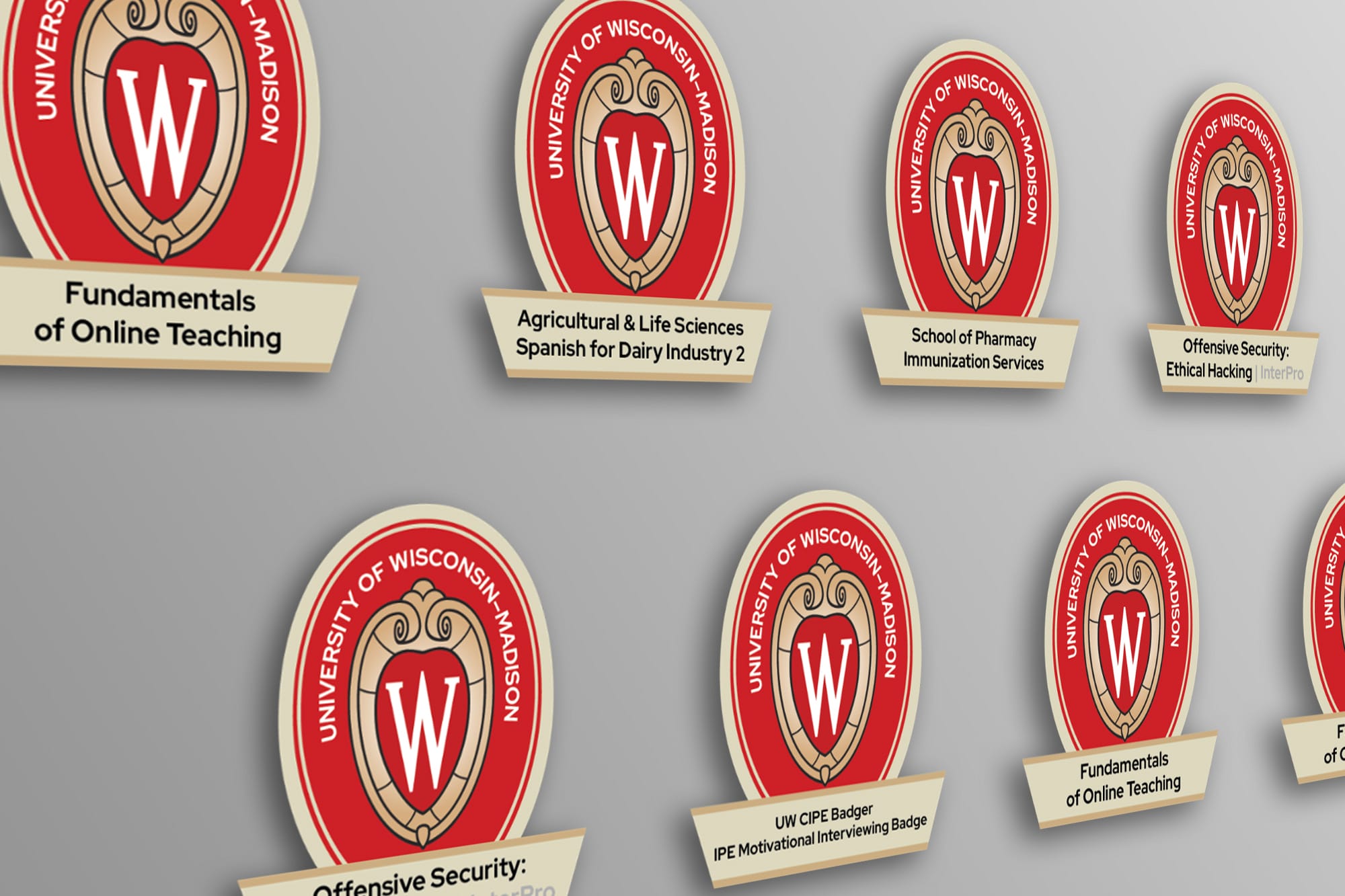
How digital badging can benefit Badgers
UW–Madison learners and alumni already stand out in job interviews. But what if, with a single click, they could show employers exactly what they know and can do?
With digital badging, they can!
In today’s fast-changing world, digital badges enhance traditional degrees and transcripts by providing verifiable credentials that showcase specific skills, achievements and expertise. Employers appreciate the quick, reliable insight into candidates’ competencies; learners benefit from a dynamic, gamified approach to skill-building; and educators gain tools to increase engagement.
Demand for digital badges is growing. According to research by Modern Campus, nearly 70 percent of learners want to fill education gaps with alternative or nondegree credentials. Another study by Modern Campus and UPCEA found that 71 percent of higher education administrators view developing new credentials as critical to revenue and enrollment growth.

“There is a trend in the Big Ten Academic Alliance to adopt digital badging to recognize diverse learning experiences,” said Sarah Korpi, director of the Learning Engineering Group in the Division of Continuing Studies, which works with units across campus to create and administer digital badges. “Notable programs are operated by Purdue, Indiana University and the University of Minnesota. Several Ivy League schools have also implemented badging programs.”
UW–Madison has a strong foundation in this space.
Korpi added, “We’ve had a digital badge policy for five years, putting us in a great position to grow our badging program,” “The policy helps ensure that our digital badges maintain their academic rigor and value for learners.”
With 86 digital badges already available across multiple schools, colleges and units, let’s take a closer look at these credentials, how they benefit learners and educators, and how to get started with badging.
What is a digital badge?
When people think of badges, they picture a name tag, a visitor pass or maybe even a scouting achievement. Digital badges take this concept online as microcredentials awarded for skills, abilities and knowledge.
But these aren’t just digital stickers — they carry real power through metadata.
“All digital badges go through a review and approval process, similar to courses,” said Korpi. “Once approved, each badge contains metadata that links it to the badge earner’s name and the specific criteria they met to demonstrate mastery.”
For example, the College of Agricultural and Life Sciences offers badges in Spanish for Dairy Industry 1 and Spanish for Dairy Industry 2:


Agriculture professionals and students working in the dairy industry can earn these badges to demonstrate their understanding of LatinX/Hispanic language and culture in the industry.
Clicking on the badge shows employers specific proficiencies attained through coursework, practice and assessments. As Korpi said, “Digital badges contain a wealth of information compared to printed certificates.”
There’s a wide variety of skills and achievements that can be recognized with badges. From technical skills to communication, team building and collaboration. “Anything that can have a learning outcome and assessment can be badged,” Korpi added.

The UW–Madison School of Pharmacy awards an Immunization Services badge to those who have completed an immunization delivery course, a written exam testing theory and practice, and an assessment of correct vaccine administration techniques.
Badges aren’t exclusive to universities, however. Companies, professional organizations and even platforms like Duolingo award digital credentials. Most often, people use their badges on LinkedIn profiles under “Licenses and Certifications,” but learners can also showcase them in resumes, email signatures, websites and social media.
Why digital badging matters
For learners, digital badges quickly and easily share verified skills with employers.
“Digital badges can help people tell the story of who they are and what sets them apart from other job-seekers,” Korpi said, adding that through UW–Madison’s digital badging platform, learners can also click on skills in their badge and see labor market data and job postings tied to those skills.
Educators and institutions also benefit from digital badging.
These credentials create a standardized way to assess and recognize skills. Badges help track skill development, providing insights into progress and achievement. They also enhance an institution’s credibility and brand while offering a modern alternative to physical certificates.
Microcredentials can also help instructors better communicate the value of their instruction.
“As experts in our fields, sometimes it’s hard for us to explain the real-world skills we’re teaching,” Korpi said. “Badges can help articulate what skills learners have mastered. That communication piece helps faculty and badge earners express learning to employers as well.”
And let’s not forget engagement.
“Badging is a form of gamification, and research says that it can increase learner activation. Gamification can also help learners solidify their learning,” Korpi said. “Our policy requires that digital badges be tied to learning experiences and assessment. So it’s not child’s play, but a meaningful way to engage.”
Be a Badger badger: How to start offering microcredentials
At UW–Madison, any unit that belongs to a school, college or division can offer digital badges. They’re widely used in the noncredit space, but opportunities abound in for-credit courses.
“There are a lot of undergraduate experiences not captured in coursework and on traditional transcripts,” Korpi said. “Digital badges can help students document and share these valuable experiences.”
Take these steps to start exploring a digital badge in your unit or program:
- Review the UW–Madison digital badge website, digital badge policy and the Continuing Studies Learning Engineering Group digital badges KB.
- Schedule a consultation with the Learning Engineering Group.
- Consult with people in your unit who are currently awarding digital badges or those who might be interested in joining your initiative.
- Compile information about your digital badge: competencies, assessments, timelines and overall badge strategy.
- Request the digital badge through Lumen.
“Digital badging is helping shape the future of education and workforce development,” Korpi said. “At UW–Madison, we’re excited to expand opportunities for learners and continue moving forward in this space.”
Ready to start badging? Take the first step today.
Published on Apr 18 2025
Last Updated on May 16 2025
Categories: Adult Career and Special Student Services, News



